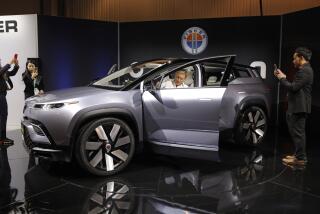Outlander Sport shows Mitsubishi is driven to compete
The relative rarity of Mitsubishi cars these days confirms the company’s status as an underdog automaker. Mitsubishi ranks sixth out of the seven Japanese manufacturers in U.S. sales, just ahead of Suzuki.
But through the first five months of 2011, sales have increased an astounding 61% versus the same period last year, making it the fastest-growing mass-market automaker in the U.S. Much of the growth is due to its newest model, the 2011 Outlander Sport. The Outlander family now accounts for almost one-third of the company’s sales.
The 2011 Outlander Sport demonstrates Mitsubishi’s embrace of a fun-to-drive, eco-friendly mandate as it presses ahead into the 21st century after a decade of turmoil that saw the company separate from Chrysler, then suffer through vehicle defects and a consumer financing fiasco.
Starting at $19,275, the Outlander Sport is a value-oriented crossover that’s priced to move the company into the future.
It’s also a crossover that strives to play off the name recognition of its older, seven-seat sibling, the Outlander SUV. The five-passenger Sport is just smaller. Although the height and width are similar and the wheelbase is exactly the same on both cars, it’s as if an X-acto knife sliced off the excess on the Outlander’s front and rear ends, shortening the car almost 15 inches and lightening the load by more than 200 pounds.
Designed to carry more things than people, the Sport does away with the Outlander’s third row of seats in favor of cargo space. A snubbed front end also offers off-roaders and mountain-goers a better incline angle going uphill.
I was testing the top-of-the-line version of the Sport, the SE. It was equipped with a premium package that upgraded the standard 16-inch wheels to 18s, among other things. The Sport is available in two trims, the base model ES with two-wheel drive, and the SE with either two- or all-wheel drive. My SE tester was all-wheel drive; it had the option of switching between two-wheel drive, and part- or full-time four-wheel drive with the help of a knob just south of the gear shift.
Driving in two-wheel drive would have saved me a few bucks in gas, but L.A. is riddled with potholes. So, even though potholes are the only inclement condition SoCal drivers are likely to experience this June, I kept the car in part-time four-wheel drive most of the time in case I needed to perform a radical swerve.
The all-wheel-drive Sport SE gets an estimated 26 miles per gallon combined, according to the Environmental Protection Agency. That’s decent for a car of this capacity, and also surprising considering its flat and wide front end. Like many new cars, aerodynamics have been optimized on the Sport, most notably around the side-view mirrors.
The Sport is powered with a 2-liter, inline-four-cylinder engine. On the SE, the transmission is continuously variable and, for those who take the car’s name to heart, equipped with paddle shifters. For those who don’t, there’s an Eco lamp that rewards drivers with a green light on the dashboard whenever they’re driving like a member of the Sierra Club.
Borrowing some technology from the automaker’s soon-to-be-released, pure battery electric vehicle called the Mitsubishi i, the Sport is equipped with a regenerative alternator that harnesses kinetic energy when the car is slowing and feeds it back into the battery to power accessories.
Mitsubishi is best known in the U.S. as an automaker, but it is also an electronics company. That resume is apparent in the car’s tastefully understated driver controls and embrace of LED lighting. Many of its dials are awash in a faint orange glow, including the edges of the panoramic sunroof in the car I was testing.
Electronics did not, however, make their way into the controls for the seat, which need to be positioned by hand. Since most people are the sole drivers of their cars and won’t need to adjust their seats daily, these manual controls are hardly a deal-breaker.
A direct competitor of the Kia Sportage and Hyundai Tucson, the Outlander Sport is another value offering in the expanding crossover category — one that offers an impressive number of features for its price point. Even on the Outlander Sport ES base model, steering wheel audio controls and Bluetooth are standard. Sirius Satellite Radio, a 710-watt stereo and the 40-gigabyte navigation system with rear-view camera are, of course, extra.
Although the Outlander Sport can be made more luxurious with factory options, it is, at its core, not as rudimentary as its base price would indicate. It’s fairly quiet, it handles well and it’s comfortable.
Mitsubishi, welcome back to the fold.






